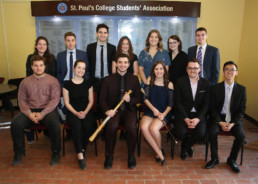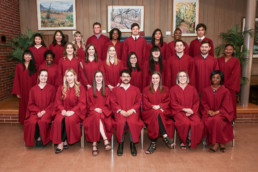The St. Paul’s College Students’ Association (SPCSA) consists of students pursuing any program of study at U of M, who are registered members of the college. SPCSA Council members are elected annually by students. Its purpose is to organize and promote events and special initiatives, and represent students’ interests (academic, spiritual, and social). SPCSA relies on the active involvement and interest of the students.
Events are planned throughout the year such as an Orientation BBQ, Beverage Gardens, Socials, Exam Crams and more. All students, faculty and staff at U of M are welcome to attend social events at St. Paul’s College.
History of the College
St. Paul’s College on the University of Manitoba campus is the major Catholic higher education institution in Manitoba.
In 1926 the Oblate Fathers, with a staff of six and a student body of one hundred, opened St. Paul’s College as the first English Catholic High School for boys in the Province of Manitoba. Fr. Alphonse Simon, OMI was the first Rector. There was a rapid increase in students and the building on Selkirk Avenue soon proved inadequate. In 1931 Archbishop Sinnott, who had worked tirelessly to get the College started from as early as 1916, purchased the old Manitoba College (which had opened in 1882) at the corner of Ellice and Vaughan Streets in downtown Winnipeg and the College moved to this new location. The direction of the College passed into the hands of the diocesan clergy and Fr. C. B. Collins was appointed Rector. In the same year, the College became affiliated with the University of Manitoba.
The University of Manitoba, as founded in 1877, was a federation of three denominational colleges: St. Boniface (Catholic), St. John’s (Anglican), and Manitoba (Presbyterian). In 1888 Wesley College (Methodist) became affiliated. On October 27th, 1931, at the time of its affiliation, St. Paul’s had a staff of 15 (eight priests and seven laymen), and a total of twelve students in the University program. The University of Manitoba Yearbook for 1932, The Brown and Gold, displays the photographs of the first two graduates of the College.
At the request of the Archbishop, the Jesuit Fathers undertook direction of the College in 1933. Fr. John Holland, S.J., was appointed Rector, and Fr. Erle Bartlett, S.J. was appointed Dean of Studies. Their photographs and those of their successors line the corridor of the administrative wing of the College. In 1936, St. Mary’s College for Women became the women’s division of St. Paul’s, until the College opened on the Fort Garry campus in 1957 when it became co-educational and St. Mary’s eventually withdrew from university work.
The facilities available to the College on Ellice Avenue were never fully adequate. Largely through the generosity of Mrs. Margaret Shea, a new unit, Paul Shea Hall, had been erected, providing a separate High School building in 1932. In 1939, six more classrooms were added and paid for through the Archdiocese and generous friends of the College. By the mid-1940s, students were being turned away because of the lack of space. A building fund drive at that time was not particularly successful and attention was turned again to relocating on the University of Manitoba campus with whom ongoing negotiations about relocation had been taking place. Following a pressing invitation from the University in 1954, there was much discussion and finally a decision was made in 1956 to accept the University’s offer. In 1957 a 99-year lease for land on the campus was signed and a cornerstone was laid and blessed by Archbishop Pocock. At that ceremony, the Honourable Mr. Miller, Minister of Education, speaking on behalf of the government, congratulated the College for undertaking the move and added to the Archbishop’s blessing “if you want governmental blessing, you have it.” The Canada council contributed $100,000 towards the construction costs. The architect was Mr. Peter Thornton, the contractors were Wallace and Aikens.
In the fall of 1958, the basic buildings and administrative offices containing classrooms, library, cafeteria, faculty offices, and the chapel were ready for the first students. About 200 registered that year.
In 1962 the Science Wing was added, containing well-furnished laboratories, further class rooms, and faculty offices. The student cafeteria was extended in 1964 and the Residence of the Jesuit Fathers was added. 1972 saw the construction of our beautiful library, a theatre to seat 200, and the addition of further classroom and faculty office space. A larger library and a student residence were part of the original plan, but were never constructed.
Presently the College is under the direction of the St. Paul’s Corporation and an 18 person Board of Governors. The Archbishop of Winnipeg is the College Chancellor and the College continues to value its commitment as a Catholic College in the Jesuit tradition.
The new millennium saw the construction of the Arthur V. Mauro Centre for Peace and Justice – an addition that provides graduate and undergraduate studies in peace-building and conflict-resolution. These programs that will help the community close to home and around the globe.

